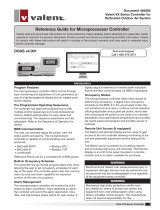
Form CP-MAPSIII-D19, Doc No 303069, Page 17
Once enabled ON, press the enter
key in succession until the cursor is
ashing in the uppermost left hand
corner of the screen and use the down
arrow key to navigate to the next Test
Mode Screen E.a.2.
7. If applicable, visibly check that the
optional unit dampers have actuated
to the full open position (Outside Air)
and full closed position (Return Air).
The damper actuators will have up
to a 120 second time period for full
stroke.
NOTE: Damper operation is required
in order to complete the Test Mode.
With proper damper operation, close
the damper access door and resume
the test at Step 8.
8 Visibly check for proper rotation of
the unit supply fan. If the fan rotation
is incorrect, the main unit electrical
supply must be de-energized. Once
de-energized, the electrical phasing
will need to be switched at the main
unit disconnect. After the unit phasing
is corrected, re-verify the unit supply
fan rotation.
With proper supply fan rotation, close
the supply fan access door, and
resume the test mode at Step 9.
9. From the Test Mode Screen E.a.2,
verify that the Supply Fan Airow
Status: is reading ON.
NOTE: Proof of supply fan airow is
required in order to complete the Test
Mode.
10. Instructions for Setting Supply
Fan to Test and Balance Airow
(Note: Applies to Options
VFD1, VFD2 or VFD3 Only)
Adjusting the unit fan speed to achieve the
desiredairowvolumeisaccomplished
on test mode screen E.a.2. Reference
an auxiliary air measuring device for
setting the maximum fan speeds. If an
adjustment is required use the Supply:
% modiable eld and the up and
down keys to increase or decrease the
commanded fan speed until the desired
airowvolumeisachieved.
If an adjustment is required, the adjusted
value will need to be saved in the TAB
Menu. Instructions for saving set point
values are in Step 15 at the end of the
Test Mode description instructions.
Press the enter key in succession
untilthecursorisashinginthe
uppermost left hand corner of the
screen and use the down arrow key
to navigate to the next Test Mode
Screen E.a.3.
11. From the Test Mode Screen E.a.3,
press the enter key until the cur-
sorisashingontheStage 1:eld.
Press the up arrow key to set the
Stage 1 value to On. Verify the
rststagecompressorandasso-
ciated condensor fan for opera-
tion. Repeat this step for stages 2
through4.Onceveried,turnall
compressor stage values off.
Press the enter key in succession
untilthecursorisashinginthe
uppermost left hand corner of the
screen and use the down arrow key
to navigate to the next Test Mode
Screen.
12. If the unit is equipped with an
optional reheat pump circuit, from
Test Mode Screen E.a.4, press the
enterkeyuntilthecursorisashing
on the Reheat Comp:eld.Press
the up arrow key to set the Reheat
Comp: value to On. Press the Enter
Keyuntilthecursorisashingon
the Reheat Capacity:eldanduse
the Up Arrow Key to set the capacity
to 100%. Verify that the Reheat
Compressor is operating and that
the refrigerant gas is now being
diverted into the indoor condensor
reheatcoil.Onceveriedsetthe




















